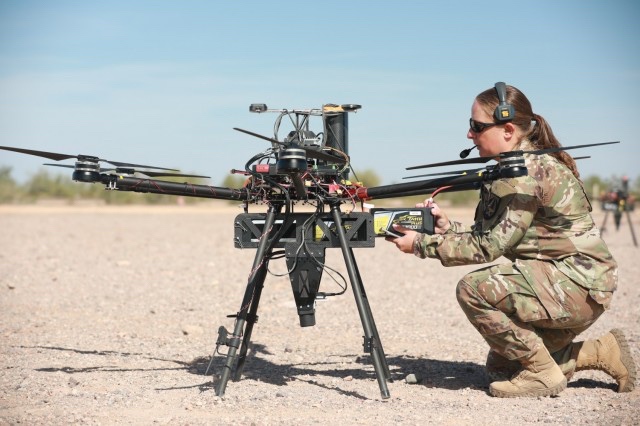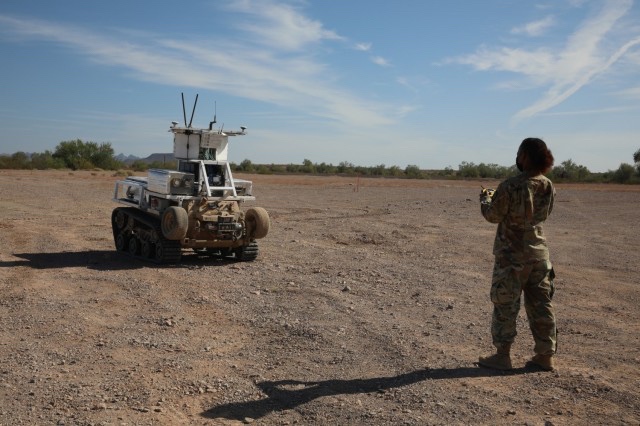
YUMA PROVING GROUND, Ariz. — Situated in a broad swath of Arizona desert, Yuma Proving Ground offers the U.S. Army a prime location for testing — or “proving” — new capabilities.
It is a fitting home base for Project Convergence 2021, a modernization experiment organized by Army Futures Command’s Joint Modernization Command.
The event brings together members of the Joint Force to test and retest novel equipment and systems.
“It’s the initial steps of working out how our joint forces will need to operate in the future,” said Joseph Cruse, data collection and analysis execution lead for Project Convergence 2021.
Dotted throughout the dusty landscape at Yuma Proving Ground are high-tech, multi-phase exercises designed to validate the utility of first-of-their-kind tactical and operational scenarios, many of which are enabled by artificial intelligence.
One such scenario explores the Army’s ability to use joint sustainment semi-autonomous resupply mechanisms to improve logistical dexterity while mitigating additional exposure and risk to Soldiers.
“The goal is to ensure that we’re able to extend our reach, especially during MDO, which is multi-domain operations,” said Maj. Christopher Jones, the lead for semi-autonomous resupply testing at Project Convergence 2021.
“We can do that by applying semi-autonomous vehicles into our formations, to provide rest for Soldiers, to take the Soldiers off the ground and expedite those pushes that we need to get out to our Soldiers,” Jones said.
The semi-autonomous resupply process, as envisioned and executed, starts with a need on the battlefield — for food, supplies, ammunition or even replacement parts for heavy machinery.
The exercise at Yuma Proving Ground specified a need for a replacement part required by a tank operator in the field, setting into motion a number of steps to deliver the essential item.
Communicating with a base of operations, the tank operator described his location and the part needed, and personnel set to work quickly to obtain the part. Those responsible for doing so assumed a spare parts-limited environment, so a replacement was fabricated using a field-ready 3D printer capable of producing both plastic and metal objects.
The Army then dispatched a small convoy of leader-follower tactical wheeled vehicles, which can be driven independently, remotely or be made to follow a vehicle, to deliver the part to an Expeditionary Modular Autonomous Vehicle (EMAV), a U.S. Marine Corps robotic vehicle, waiting at the (simulated) fighting edge.
Once the part was secured to the platform of the EMAV, Soldiers sent remote communications from a distance, signaling to the vehicle exactly where it should deliver the item. When it received the message, the previously still machine revved into gear, kicking tan dust onto its black tracks and road wheels as it accelerated up a hill and turned toward its destination.

According to Dr. David Stone, a senior robotic engineer with the Marine Corps Warfighting Lab, the EMAV is operational in all terrains, possessing the ability to not only travel through muddy fields but also to pull other vehicles out of the mud. Despite its relatively smaller size, “the thing’s basically a truck,” Stone said.
Stone elaborated that the EMAV, which is a diesel-electric hybrid, is “very robust. Its versatility and the modular aspect — being able to do different warfighting functions — is the real value of it.”
Originally designed to accompany dismounted Marines, the durable autonomous vehicle can also serve the needs of Joint Force missions, as evidenced by the exercise.
“Between the Army and Marine Corps, we are going after the same thing,” Stone said. “Anything we can do to leverage on another’s work helps us do more with the money we have.”
While an EMAV was used for the training exercise, the Army also intends to use its Robotic Combat Vehicle-Light to serve a similar purpose in future semi-autonomous resupply missions.
Following the arrival to its destination approximately two miles away, and the human-assisted replacement of the tank part in the exercise, the EMAV returned to its starting point, powering easily through gravel and dirt as it traveled among a group of heavy military trucks.
The scenario demonstrated how the U.S. military can integrate new field-deployable technologies with existing ones, offering additional options to commanders while decreasing the human footprint necessary to carry out logistical resupply missions.
“People who are supplying us with ammo, water, food, etcetera — anything that puts Soldiers at risk, the EMAV takes them out, and it saves lives,” said Pfc. Daniel Candales of 1-508 Parachute Infantry Regiment, 3rd Brigade, 82nd Airborne Division, who was trained on the various functions of the vehicle.
The Army is additionally working to develop complementary capabilities that would allow for autonomous loading of supplies and digital tracking of items and vehicles and testing prototypes for these systems at Project Convergence 2021.
Reducing the need for hands-on support will also enable Soldiers who would otherwise be assisting with resupply chains to tackle other priority tasks. In addition, augmenting methods for delivering necessary equipment and supplies over treacherous ground will bolster the Army’s ability to function effectively across multiple domains.
“Logistics is something we always have to improve upon,” said Command Sgt. Maj. Robin M. Bolmer of the Army’s Futures and Concepts Center, who observed the exercise. He explained that new technologies open up numerous possibilities for growth, but that “the need to sustain what we have is always going to be there.”
The Futures and Concepts Center developed the initial concepts for many of the technologies and systems being tested during Project Convergence 2021, and will assume responsibility for organizing Project Convergence 2022, which is slated to include the participation of U.K. and Australian forces.
Bolmer shared that he was observing this year’s activities with an eye toward continual modernization progress, keeping the question of “how do we build upon all the great work being done here?” always at the forefront of his mind.
By Maureena Thompson, Army Futures Command

